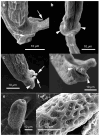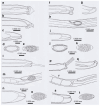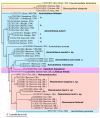Integrated Taxonomic Approaches to Gastrointestinal and Urinary Capillariid Nematodes from Wild and Domestic Mammals
- PMID: 40430775
- PMCID: PMC12114645
- DOI: 10.3390/pathogens14050455
Integrated Taxonomic Approaches to Gastrointestinal and Urinary Capillariid Nematodes from Wild and Domestic Mammals
Abstract
Fine nematodes of the family Capillariidae parasitize various organs and tissues in fish, amphibians, reptiles, avians, and mammals. Currently classified into more than 20 genera, these nematodes are primarily distinguished based on the caudal structures of male worms. Morphological and molecular analyses were conducted on 15 mammal-parasitic species belonging to the genera Aonchotheca (A. putorii, A. suzukii n. sp., A. suis n. comb. (syn. Capillaria suis), A. riukiuensis, and A. bilobata), Pearsonema (P. neoplica n. sp., P. feliscati, P. iharai n. sp., and P. toriii n. sp.), Liniscus (L. himizu), Calodium (C. hepaticum), Echinocoleus (E. yokoyamae n. sp.), and Eucoleus (E. kaneshiroi n. sp., E. aerophilus, and Eucoleus sp.), using specimens from various wild and domestic animals in Japan and brown rats in Indonesia. As demonstrated in this study, nearly complete SSU rDNA sequencing is a powerful tool for differentiating closely related species and clarifying the phylogenetic relationships among morphologically similar capillariid worms. Additionally, most capillariid worms detected in dogs and cats are suspected to be shared with their respective wildlife reservoir mammals. Therefore, molecular characterization, combined with the microscopic observation of these parasites in wildlife mammals, provides a robust framework for accurate species identification, reliable classification, and epidemiological assessment.
Keywords: Aonchotheca; Calodium; Capillariidae; Echinocoleus; Eucoleus; Liniscus; Pearsonema; SSU rDNA; Trichosomoides crassicauda; morphology; taxonomy.
Conflict of interest statement
The authors declare no conflicts of interest.
Figures
















Similar articles
-
Integrated taxonomic approaches to seven species of capillariid nematodes (Nematoda: Trichocephalida: Trichinelloidea) in poultry from Japan and Indonesia, with special reference to their 18S rDNA phylogenetic relationships.Parasitol Res. 2020 Mar;119(3):957-972. doi: 10.1007/s00436-019-06544-y. Epub 2019 Dec 6. Parasitol Res. 2020. PMID: 31811424
-
Ribosomal and mitochondrial DNA analysis of Trichuridae nematodes of carnivores and small mammals.Vet Parasitol. 2013 Oct 18;197(1-2):364-9. doi: 10.1016/j.vetpar.2013.06.022. Epub 2013 Jul 4. Vet Parasitol. 2013. PMID: 23920054
-
Proposal of a new systematic arrangement of nematodes of the family Capillariidae.Folia Parasitol (Praha). 1982;29(2):119-32. Folia Parasitol (Praha). 1982. PMID: 7106653
-
Worldwide paleodistribution of capillariid parasites: Paleoparasitology, current status of phylogeny and taxonomic perspectives.PLoS One. 2019 Apr 30;14(4):e0216150. doi: 10.1371/journal.pone.0216150. eCollection 2019. PLoS One. 2019. PMID: 31039193 Free PMC article.
-
An overview of the host spectrum and distribution of Calodium hepaticum (syn. Capillaria hepatica): part 2-Mammalia (excluding Muroidea).Parasitol Res. 2014 Feb;113(2):641-51. doi: 10.1007/s00436-013-3692-9. Epub 2013 Nov 21. Parasitol Res. 2014. PMID: 24257974 Free PMC article. Review.
References
-
- Freitas T.J.F., Lent H. Estudo sobre os Capillariinae parasitos de mammiferos: (Nematoda: Trichuroidea) Mem. Inst. Oswaldo Cruz. 1936;31:85–160. doi: 10.1590/S0074-02761936000100006. - DOI
-
- López-Neyra C.R. Los Capillarinae. Mem. Real Acad. Cienc. Exactas Fis. Nat. Madrid. Ser. Giencias Nat. 1947;12:1–248.
-
- Skrjabin K.I., Shikhobalova N.P., Orlov I.V. Essentials of Nematology. Trichocephalidae and Capillariidae of Animals and Man and Diseases Caused by Them. Volume VI Academy of Sciences of the USSR, Moscow, USSR; Moscow, Russia: 1957. pp. 1–599. Jerusalem, Israel Program for Scientific Translations.
-
- Butterworth E.W., Beverley-Burton M. The taxonomy of Capillaria spp. (Nematoda: Trichuridea) in carnivorous mammals from Ontario, Canada. Syst. Parasitol. 1980;1:211–236. doi: 10.1007/BF00009847. - DOI
-
- Moravec F. Proposal of a new systematic arrangement of nematodes of the family Capillariidae. Folia Parasitol. 1982;29:119–132. - PubMed
MeSH terms
Substances
LinkOut - more resources
Full Text Sources
Medical
Research Materials
Miscellaneous

